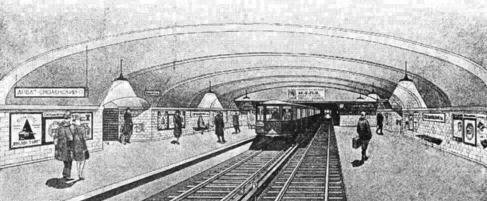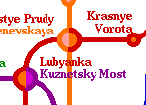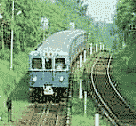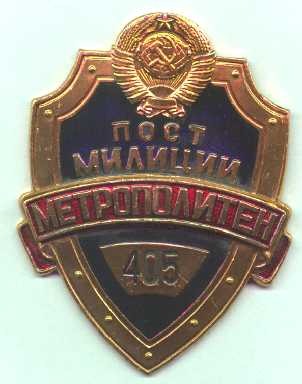Wellcome to MOSCOW! Opened August, 30 1997. |
Technical Information
| Год открытия: | 1935 | ||
| Lenth: | 262 km | ||
| Gauge: | 1.524 m | ||
| Powersupplay: | 825 V DC | ||
| Питание: | третий рельс | ||
| Number of station: | 164 | ||
| Number of cars: | 3850 | ||
| Пассажирооборот: | 3207 млн. пасс./год |
General Information
Moscow Metro (still named after V.I.Lenin) is considered to be one of the best in the world. Its stations impress with their architectural solutions, the trains are fast, the cars are comfortable, and the traffic organization is accurate.
Nowadays, it is impossible to imagine Moscow without the Metro. It has become an inalienable part of the city, and it is the most convenient and the fastest city transit.
Краткая история - Brief History
An idea to build the Metro in Moscow was born as a draft project in 1901. In 1902, Russian engineer P.I.Balinsky introduced a project of constructing an out-of-street railway, that would connect Zamoskvorechie, the Downtown, and Tverskaya Zasatava (city gates, now the square of the Byelorussky railway terminal), to the city Duma (counsil). To save money, the
author of the project planned to make the Metro not very deep, and to build elevated passes over Red Square and Strastnaya (now Pushkin) Square.
However, the project has never been implemented because of the opposition of horse-powered and electric tram owners and the clergy, and lack of money and experience. The municipal counselors did not want to engage the foreigners in the construction, so the Duma rejected the project. There is a picture in Moscow Museum of History and Reconstruction showing a hypothetical elevated road over Red Square with a three-car train driving over the heads of people in horse carriages.
 Ten years passed, and in 1912 a new project of the Moscow underground railway was discussed in the City Duma. The project provided for building three underground lines: from the Smolensky marketplace to Kalanchevskaya (Komsomolskaya) Square, between Tverskaya and Pokrovskaya (Abelmanovskaya) Zastavas, and between the Vindavsky (Rizhsky) railway terminal and Serpukhovskaya
(Dobryninskaya) Square. These Metro lines were planned to be connected to existing railways. The World War I prevented from the realization of this project.
Ten years passed, and in 1912 a new project of the Moscow underground railway was discussed in the City Duma. The project provided for building three underground lines: from the Smolensky marketplace to Kalanchevskaya (Komsomolskaya) Square, between Tverskaya and Pokrovskaya (Abelmanovskaya) Zastavas, and between the Vindavsky (Rizhsky) railway terminal and Serpukhovskaya
(Dobryninskaya) Square. These Metro lines were planned to be connected to existing railways. The World War I prevented from the realization of this project.
In six more years, Moscow became the capital of the state, and in 1918 the first plan of the city's major reconstruction was elaborated under the direction of Vladimir Lenin. Later, Lenin met the arcitects and designers and approved the idea of constrcuting the Metro, and by 1922 the Metro project was completed. However, economic difficulties, insufficient industrial base, and lack of experienced engineers and workers did not allow to begin the construction.
In 1925, a project of so-called Myasnitsky Metro line was elaborated, but it did not satisfy the transportation needs of the Muscovites, and was rejected.
The final decision on the Moscow Metro construction was adopted only six more years lates, in 1931, in the June Plenary Session of the Central Committee of the VKP(b) (the communist party). The same year, the newly created Mosmetrostroi company began the construction.
The fist mine of the Moscow Metro appeared at Rusakovskaya Street. The first test train was set in operation on October 15, 1934, and on May 15, 1935, the first thirteen stations were opened for public use. This day is now celebrated as the birthday of the Soviet Metro.
Reports, Stories and Other Resources
![[SIGN]](moscow.gif)
- Moscow metro by Alexander K. - not bad.
- Metrp what we have lost by Justas.
- Moscow metro by Artemy Lebedev
- Moscow metro by Vladimir Svidernikov
- Moscow metro: dream from underground! Автор рассматривает Московское метро как произведение искусства. Этот сайт - на английском языке.
Maps

- Схема 1 - 3 очередей метро Похоже, нарисована была недавно, хотя исторически относится к 1943-1947 гг. (между пуском "Автозаводской" и переименованием "Коминтерна").
- Схема линий Московского метрополитена -- немного нетрадиционная, но, кажется, достаточно удобная
- Схема перспективного развития. Осторожно: она огромная!
- Интерактивная схема с возможностью поиска кратчайшего пути
- Интерактивная схема, написанная на яве
- Полуофициальная схема, присланная Р. Бейкером
- Еще одна схема
- Hello, Russia! company presents screenshot automated metromap for Windows. Разработчики утверждают, что программа умеет находить кратчайший путь и даже произносить названия станций! (Интересно, кому это нужно).
Pictures

- "Yauza" -- the newest piece of Moscow Metro rolling stock (this is actually not "Yauza" itself but a "Yauza"-based railcar)
- SM-M2 snow plough
- Kievskaya station hallway (Koltsevaya line)
- Библиотека им. Ленина - наземный вход
- Библиотека им. Ленина - интерьер
- Чистые пруды
- Комсомольская-радиальная
- Краснопресненская
- Красные ворота - интерьер
- Кропоткинская - наземный павильон - 1
- Кропоткинская - наземный павильон - 2
- Кропоткинская - интерьер
- Лубянка
- Маяковская
- Охотный ряд - наземный вход
- Охотный ряд - интерьер
- "A well decorated metro station made to look like a hallway from a Czar's palace..."
- One more picture of Metro hall.
- Entrance of the Kropotkinskaya station
- Smolenskaya Station (Arbatsko-Pokrovskaya line)
- A train approaching Izmailovsky Park station (Arbatsko-Pokrovskaya line)
- A wonderful Photo Gallery created by Alexey Dobkin: the Metro as we ride it day after day, without polish...
Жетоны метро -- Metro tokens
Новинка! Стоимость одной поездки в Московском и Ленинградском метрополитенах за последние 15 лет -- инфляция-с :-)Before the end of the 80s, 5-kopek (ca. 3 cents at that time) coins were used as Metro tokens. The same coins were accepted by the automated ticket-vending machines (kassa's) in the buses, trolleybuses, and trams. Changing machines were available at each Metro station. At the end of the 80s, when these coins lost their value because of the inflation, special copper tokens were introduced (later replaced by green transparent plastic tokens). Both sides of the tokens are identical. Click onto the icons to see colorful GIF images:
![]()




